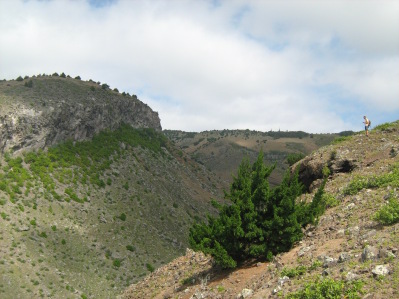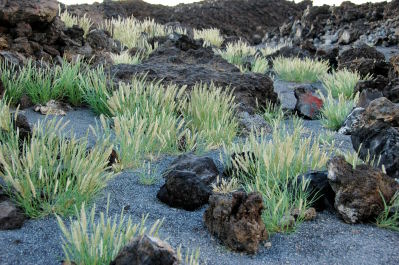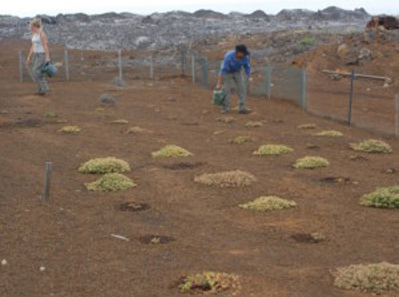


Situated 7º South of the equator and 1500 km from the coast of west Africa, the Island of Ascension was born circa one million years ago. There has been no recent volcanic activity, although some of the youngest lava flows may be less than 1000 years old. Ascension's volcanic past has produced a complex of rocks. Pale trachyte types predominate in the east, and form the dome of Green Mountain, the highest point on the island at 859 metres. Younger, red basaltic rocks cover most of the west, forming a stark lowland plain permeated by jagged black lava flows. The plain is dotted with at least 22 volcanic cones formed from rock particles ejected from secondary vents. There are virtually no sources of fresh water except for where moisture seeps through rocks on the upper slopes. The temperature is remarkably constant, ranging from a daytime average of 27º C at sea level in September to 30º C in January. Green Mountain receives 680mm of rain annually, and often accumulates cloud and mist. As little as 130mm falls in the lowlands, mostly in torrential downpours between March and May. For most of the year, the lowlands are therefore arid and desert-like.
Ascension is both very young and extremely isolated. In evolutionary terms its ecology is still in the early stages of development. Therefore, very few plant species have managed to colonize naturally, and even fewer have evolved into distinct species from their mainland relatives. In 1843, the eminent botanist Joseph Hooker visited the island and proposed that plantations of large trees should be established on Green Mountain to intercept humid air and increase rainfall, and that the lower slopes should also be 'greened' in order to prevent erosion. Over the next few years, seed from many different tropical plant species were sent out from RBG Kew. Goats, rabbits, sheep and donkeys also became established, with the result that the endemic flora was all but eradicated and replaced by a patchwork of vigorous, highly invasive species. Subsequent introductions have continued to modify the landscape of the lowland areas. From early accounts, it appears that the island was a very barren place, with most of the vegetation restricted to Green Mountain. Current knowledge and early records indicate there were at least 6 endemic species of ferns, two grasses and two small shrubs. Several plant species had also arrived, probably from Africa, and these were mostly restricted to the rocky lowlands.

The lowlands would have been very bare and rocky. Only one endemic, the Ascension Island spurge (Euphorbia origainoides), is known from this zone, although species such as camel's-foot creeper (Ipomoea pes-caprae), purslane (Portulaca oleracea), hogweed (Commicarpus helenae) and Cyperus appendiculatus were also probably present. Once every 15-20 years, Ascension Island receives unusually heavy rains, and during these periods, a flush of vegetation may appear in the lowlands. Two grasses, Aristida ascensionis and Enneapogon cenchroides, are well adapted to respond to these conditions and their seed may lie dormant for many years. Both also occur in tropical Africa. Today, only the endemic Asplenium (Ascension Island spleenwort) is still relatively common. Four other endemics (Oldenlandia, Dryopteris, Anogramma and Sporobolus) are all thought to be extinct and the remaining species cling to rocky refuges inaccessible to sheep. The lowlands remain barren and inhospitable, although some common global weeds such as billy-goat weed (Ageratum conyziodes) have gained a foothold and may be very abundant in wetter years. As recently as the 1960s, Mexican thorn (Prosopis juliflora) began to spread in the lowland basin behind Georgetown, forming dense thickets in this part of the island. Green Mountain was originally covered with a carpet of ferns, composed of the endemics Marattia purpurascens, Pteris adscensionis, Anogramma ascensionis and Dryopteris ascensionis, and some globally widespread species, such as Christella dentata and Histiopteris incisa. Further endemics confined to rocky crevices included the ferns Asplenium ascensionis and Xiphopteris ascensionis and the tiny grass Sporobolus caesitosus. At lower altitudes, sparser patches of the fern communities would have persisted, joined by the endemic shrub Oldenlandia adscensionis and another grass, Sporobolus durus. Further native ferns may have included stagmoss (Psilotum nudum), adder's tongue (Ophioglossum vulgatum) and Nephrolepis hirsutula.
The upper slopes of Green Mountain are now clothed in dense forest and scrub composed of species such as shell ginger (Alpinia zerumbet), lovechaste (Vitex trifolia), koster's curse (Clidemia hirta) and bramble (Rubus pinnatus).

Ascension is an exceptional example of a region modified by introduced species from widely differing parts of the world over a very short space of time. Understanding the development of the new ecosystems, and how to manage them effectively, is a considerable challenge.
Please use the links below to see further details on conservation activities in the UK Overseas Territories.
British Indian Ocean Territory
South Georgia and the South Sandwich IslandsSovereign Base Areas on Cyprus
Homepage of the UKOTs Online Herbarium





